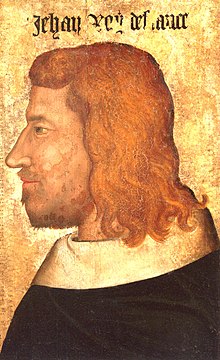October 25, 1415:
The Longbow and Agincourt
This text comes from our book, Light to the Nations I: The History of Christian Civilization. For ordering information on this text and our other books, please click here.
For another six years after the Battle of Sluys, the English and French fought no important battles. In 1346, however, Edward III crossed the English Channel with 15,000 men and captured the city of Caen in Normandy. The English then moved east, pillaging the country as they went. Philip, with an army of about 20,000 men, moved north. On August 26, 1346, the English and the French met at Crécy, near the Flemish border.
 |
| 15th century depiction of the Battle of Crécy |
At Crécy, Edward III's army used a new weapon, the cannon. The cannon used by the English, however, was not the powerful weapon it would become. It was a crude, smooth-bore gun capable of only short-range firing of two- to three-pound iron balls. But Edward's cannon caused panic in the French cavalry lines, scaring and crippling horses and men with bouncing blows.
 |
Image of a longbowman, from the
village sign for Crécy
|
A more effective English weapon was the longbow, a five-foot-long bow of seasoned yew that could fire a deadly rain of arrows in half the time it took to load, crank, and fire a crossbow. At Crécy, rain and damp spoiled the bowstrings of the French crossbowmen while the English longbowmen kept theirs dry by rolling them up under their helmets. The French cavalry milled around, unable to move in unity against the English lines, because the English longbowmen sent barrage after barrage of arrows against them, hitting horses as well as men. The horses panicked and fell back, crushing the foot soldiers behind them and leaving the troops open to the English assault. Because of the longbow, Crécy was a resounding English victory.
In the ten years after the Battle of Crécy, the English and French engaged in a few skirmishes but no great battles. In 1356 Edward III's son, Edward the "Black Prince" (so named for the color of his armor), led a small force from Guienne in the south of France and met the French in battle at Poitiers. Again, the longbow gave the victory to the English, who captured John II "the Good," who had become king of France in 1350.
 |
| King John II of France |
With King John a prisoner in England, his son Charles, the Dauphin, took over the government of France. Charles was an able and courageous leader who successfully resisted the English. In 1360, King Edward III and Charles signed the Treaty of Brétigny, in which Charles gave Edward the French territories of Aquitaine, Calais, and Ponthieu. In return, Edward gave up all claims to the French crown. The treaty said King John was to be ransomed. But when the French could not pay the required ransom, the chivalrous old French king, whom the English had freed in order to raise the needed funds for his release, voluntarily returned to England. He had made an oath that he would not try to escape, and he kept it. King John died in London in April 1364.
After the death of John the Good, the Dauphin became king as Charles V. The new king was an able ruler who, despite the peace treaty, continued the war with England.With the help of his commander in chief, Bertrand du Guesclin, Charles was able to take back many of the territories he had given to England in the Treaty of Brétigny. By 1380, the English held only the coastal towns of Bordeaux, Bayonne, and Calais.
When both Charles V and Guesclin died in 1380, France faced an uncertain future. The new king, Charles VI, was weak and mentally unstable. Furthermore, instead of having a strong adviser like Guesclin to guide him, the king was surrounded by men interested only in their personal advantage. Under Charles VI, France was thus not prepared to resist the energetic kings who soon would sit on the English throne.
 |
| John of Gaunt |
 |
| King Henry V |
Richard II in the end had so little support that he could not defend himself when his cousin, Henry Hereford, led a rebellion against him in 1399. Henry was John of Gaunt's son who, when his father died, was supposed to inherit the duchy of Lancaster. Instead, fearing Henry as a rival, Richard had sent him into exile. Returning from exile, Henry Hereford faced little opposition and forced Richard to surrender to him. The king was arrested and most probably murdered in prison. Hereford took the throne as Henry IV, thus establishing a new ruling house -- the House of Lancaster. Richard II was the last of the Plantagenet kings of England.
Henry IV was an able and energetic king. In 1413, his equally able and energetic son, Henry V, succeeded him as king. At the same time, in France, Charles VI had grown insane. He could do nothing as his kingdom was torn by civil war between the supporters of the duke of Burgundy and the "Armagnacs," supporters of the duke of Orléans. In 1415, Henry V took advantage of the civil unrest in France and landed an army at Calais. On October 25, 1415, at Agincourt in northern France, Henry's outnumbered forces defeated the heavy armored French cavalry, slaughtering many of the leading nobility of France. As at Crécy and Poitiers, so at Agincourt; it was the longbow that gave the English the victory over French chivalry.
 |
| A 15th century depiction of the Battle of Agincourt |
Music of the Ars Subtilior
This piece, composed about the year 1400 by the French composer, Johannes Symonis Hasprois, is an example of a style called the Ars Subtilior ("more subtle art"), characterized by a complex rythmnic and melodic style.

No comments:
Post a Comment